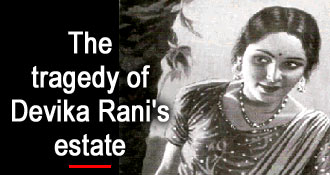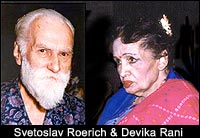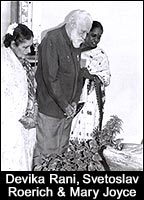DEVIKA RANI CHAUDHURI
BIOGRAPHY OF THE LEGEND
தேவிகா ராணி சௌத்திரி ரோரிக் (Devika Rani Chaudhuri Roerich, வங்காள: দেবিকা রাণী) (தெலுங்கு: దేవికా రాణి) (30 மார்ச்சு 1908 – 9 மார்ச்சு 1994) இந்தியத் திரைப்பட உலகின் துவக்க காலங்களில் நடிகையாக புகழ்பெற்றவர்.
.
பணிவாழ்வு
தேவிகா ராணி வால்டேர் என்றழைக்கப்பட்ட விசாகப்பட்டிணத்தில் சிறப்புமிகுந்த குடும்பமொன்றில் மார்ச்சு 30, 1908இல் பிறந்தார். நோபல் பரிசு பெற்ற இந்தியர் இரவீந்திரநாத் தாகூரின் குடும்பத்துடன் தொடர்புடையவர். தேவிகாவின் தந்தை எம். என். சௌத்திரி மதராசின் முதல் இந்திய தலைமை அறுவை மருத்துவராக (Surgeon-General of Madras) பணியாற்றியவர். தாயார் பெயர் லீலாவாகும்.
1920களில் தனது துவக்க பள்ளிப்படிப்பை முடித்தார். பின்னர் ஐக்கிய இராச்சியத்தின் நாடகக் கலைக்கான வேந்திய அகாதமியிலும் (RADA) வேந்திய இசை அகாதமியிலும் உதவித் தொகைகளுடன் பயின்றார். தவிரவும் கட்டிட வடிவமைப்பு, நெசவுப்பொருட்கள், உள்வடிவமைப்பு போன்றவற்றிலும் கல்வி கற்று எலிசபெத் ஆர்டென் கீழ் பயிற்சிப் பணியாற்றி வந்தார். இங்குதான் பிற்காலத்தில் அவரது பல வெற்றித் திரைப்படங்களுக்கு திரைக்கதை எழுதிய நிரஞ்சன் பாலை சந்தித்தார்.
1929ஆம் ஆண்டில் இந்தியத் தயாரிப்பாளரும் நடிகருமான இமான்ஷூ ராயை திருமணம் புரிந்தார். இருவரும் 1933ஆம் ஆண்டில் வெளிவந்த கர்மா என்ற திரைப்படத்தில் இணைந்து நடித்தனர். தொடர்ந்து பம்பாய் டாக்கீஸ் என்ற திரைப்பட தயாரிப்புத்தளத்தை நிறுவினர். நிரஞ்சன் பால் மற்றும் பிரான்சு ஓஸ்டென் ஆகியோருடன் இணைந்து சாதி அமைப்புகளை சாடி திரைப்படங்கள் எடுத்தனர். இந்த காலகட்டத்தில் இவர்களுடன் நடித்தவர்களில் அசோக் குமார், மதுபாலா குறிப்பிடத் தக்கவர்கள்.
தேவிகா ராணியும் அசோக் குமாரும் அச்சுத் கன்யா என்ற படத்தில் (1936).
1936இல் தன்னுடன் நடித்து வந்த காதலர் நஜம் உல் அசனுடன் தேவிகா ராணி ஓடிவிட்டார்.இருப்பினும் கணவர் ராய் அவரை மீளவும் அழைத்துக்கொண்டார். ஆனால் நஜம் அசன் திரும்பாதநிலையில் தன்னுடைய நிறுவனத்தில் பணிபுரிந்துவந்த அசோக் குமாரை முதன்மை வேடத்தில் நடிக்க வைத்து திரைப்படத் தயாரிப்பைத் தொடர்ந்தார். அச்சுத் கன்யா என்ற அந்தத் திரைப்படத்தில் அசோக் குமார் பிராமண இளைஞராகவும் தேவிகா தீண்டத்தகாத இனப்பெண்ணாகவும் நடித்தனர்.
தனது கணவருடன் நடித்த கர்மா திரைப்படத்தில் திரைப்பட உலகிலேயே சாதனையாக நீண்ட நேரம் இதழோடு இதழ் முத்தக் காட்சியில் நடித்துள்ளார். நான்கு நிமிடநேரம் நீடித்த அந்த முத்தம் கட்டுப்பெட்டியான இந்திய சமூகத்தில் அப்போது பெரும் சர்ச்சையைக் கிளப்பியது.[1]
பிந்தைய வாழ்க்கை
1940இல் கணவனை இழந்தபிறகு அவரது பம்பாய் டாக்கீஸ் படப்பிடிப்புத் தளத்தை கட்டுப்பாட்டுக்குள் கொண்டுவர முயற்சித்தார். ஆனால் அதன் நிர்வாகத்தை சசாதர் முகர்ஜியுடன் பகிர்ந்து கொள்ள வேண்டியதாயிற்று. 1943ஆம் ஆண்டில் சசாதர், அசோக்குமார் மற்றும் பிற பம்பாய் டாக்கீஸ்காரர்கள் பிரிந்து சென்று பிலிம்ஸ்தான் என்ற திரைப்பிடிப்பு தள நிறுவனத்தை உருவாக்கினர். இதன்பின்னர் பம்பாய் டாக்கீஸ் மெதுவாக மங்கத் துவங்கியது. 1945ஆம் ஆண்டில் தேவிகா இசுவேதோசுலாவ் ரோரிக்கை திருமணம் புரிந்து பெங்களூருவில் வாழத் தொடங்கினார். கனகபுரா சாலையில் அமைந்திருந்த பரந்த டாடாகுனி எஸ்டேட்டில்1994ஆம் ஆண்டில் தமது மறைவு வரை வாழந்திருந்தார்.[2] அவரது மறைவிற்குப் பின்னர் இந்த எஸ்டேட்டின் உரிமை குறித்து இந்திய உருசிய அரசுகளிடையேயும் உறவினர்களிடையேயும் பெரும் பிணக்கு ஏற்பட்டு நீதிமன்றம் சென்றனர்.
1958ஆம் ஆண்டில் இந்திய அரசு பத்மசிறீ விருது வழங்கியது. 1969ஆம் ஆண்டு இந்தியத் திரைப்படத்துறையின் மதிப்புமிக்க விருதான தாதாசாகெப் பால்கே விருது நிறுவப்பட்டபோது அதனைப் பெற்ற முதல் கலைஞராக பெருமை பெற்றார். அவரது மறைவின்போது அவரது உடலுக்கு முழு அரசு மரியாதை வழங்கப்பட்டது.
The Rediff Special/M D Riti

She might have been one of India's greatest film actresses and he might have been one of the greatest artists of the 20th century. But for almost a decade, the graves of Devika Rani and her husband Svetoslav Roerich were just anonymous rectangles of earth, marked at the corners by ordinary bricks. Now, the Karnataka government has begun building memorials to mark these two spots on the couple's beloved Tataguni estate, just outside Bangalore.
Not only that, the Karnataka high court recently approved the acquisition of the estate by the government to establish an art gallery and a museum of the couple's art works, carvings, and painting collection and preserve its valuable tree growth. A board of trustees headed by the state's chief secretary and consisting largely of government secretaries will govern this estate.
Waiting to be displayed in this museum are 210 of Roerich's paintings, which have been stored temporarily at the Venkatappa Art Gallery. But more than double that number of his invaluable paintings --- almost the entire series of 515 paintings he made of the Kulu Valley --- are missing. Art historians estimate that each work in this series could fetch Rs 50,000 at the very least. Aditi Vashisht, Roerich's long-time friend and former principal of a well-known Bangalore school, has a few of his paintings, which he had gifted to her in his lifetime.
 There are also many icons in storage, ready for display, though many of the more precious ones have gone missing. Thirteen valuable sandalwood trees have also disappeared from the Tataguni estate. Of the estate's original 340 silver oak trees, only 115 remain.
There are also many icons in storage, ready for display, though many of the more precious ones have gone missing. Thirteen valuable sandalwood trees have also disappeared from the Tataguni estate. Of the estate's original 340 silver oak trees, only 115 remain.
The Roerichs' long-time personal assistant, Mary Joyce Poonacha, is facing criminal charges. At present, she is out on bail and lives in Bangalore. The police have filed cases against her for theft, cheating, and breach of trust. Also accused is her husband, Manepanda Acheya alias Anil Poonacha, and P M Nandakumar, a friend of the Poonachas. These cases are pending for more than six years now and the government might wait a while for their resolution before going ahead with its plans for the estate.
Interestingly, when the Roerichs had wanted to set up a similar trust a decade ago, they had named S M Krishna, now chief minister of the state, as a member, though he later said his name was included without his consent. The chief difference between the trust proposed by the government and the one ostensibly conceptualised by the Roerichs was that the latter featured Mary Joyce prominently.
The Karnataka government had also, in the Roerichs' lifetime, proposed the idea of acquiring the estate, which extends over an area of 500 acres. "The government does not want the estate to disintegrate and would like it to be preserved as a public park and city forest," then chief minister Sarekoppa Bangarappa had said. But the idea met with stiff opposition, since the public suspected Bangarappa's motives in anything to do with land deals.
Also rather disturbing is the fact that only about 21 pieces remain from the couple's legendary and well-documented jewellery collection. What happened to the other 319 pieces is now in the realm of conjecture, but if rumours are to be believed, politicians, the Roerichs' employees and friends, and even a couple of police officers have had a hand in their disappearance. The jewellery was the joint collection of Devika Rani, her first husband, the legendary film-maker Himanshu Rai, Svetoslav Roerich and Helena Roerich, and Devika Rani's father M N Chaudhari, who was the first surgeon-general of the Madras presidency at the start of the 20th century.
 The missing pieces are all heirlooms. Soon after the Roerichs died, the Bangalore police recovered some of the jewellery from Anil Poonacha and a jeweller called Chainraj, who had a shop close to Mary Joyce's house.
The missing pieces are all heirlooms. Soon after the Roerichs died, the Bangalore police recovered some of the jewellery from Anil Poonacha and a jeweller called Chainraj, who had a shop close to Mary Joyce's house.
It is feared that if the government does not move speedily and complete both the acquisition proceedings and the categorisation of the remaining artworks and other assets, they too might gradually disappear. "Roerich's heritage is being looked after by qualified persons in New York and Moscow," says Russia's Ambassador to India Alexander Kadakin. "We should not allow culturally half-baked people to deal with the Roerichs' art over here."
The Russian government has still not given up hope of moving Roerich's body, now interred in Tataguni estate, back to Moscow and burying it in style in a grand memorial there. This is something they wanted to do back in 1993, when Roerich died in Bangalore on January 30.
Sources who were close to the Roerichs say Kadakin and the other diplomats, who rushed to Bangalore on hearing of Svetoslav's demise, were against Mary Joyce accompanying the cortege. They reportedly warned Devika Rani quite explicitly that Mary Joyce might face the wrath of the Russian people, as many Russians believed she had a hand in Roerich's ill health in his last years.
Devika Rani reacted by saying that Roerich was best buried in Bangalore, in his beloved estate. "Doctor did express the desire to be buried in his birthplace, if possible," she said. "If not, he wanted to be buried in Tataguni. He left the decision to me. If I cannot accompany the body to Russia due to ill health and climatic conditions, would the Doctor have liked to be buried in my absence?"
Devika Rani suffered greatly from respiratory ailments by then, further aggravated by her habit of smoking four or five packets of cigarettes a day. She took great pains, however, to ensure that she was never photographed with a cigarette in her hand, or without make-up on her face. "My first husband Himanshu Rai always told me to be careful about those two things," she once told me.
In the last few years of their lives, the Roerichs were transformed from leading a private but posh existence, shuttling between their estate and their office in the heart of Bangalore, to an ailing, forgetful, old couple surrounded by an entourage of nurses, drivers, and other personnel. The couple found it hard to remember friends and sustain long, intelligent conversations. Everyone thought this was a natural phenomenon caused by age, but later there were rumours about something being amiss, though nothing was ever proved.
Roerich was operated upon for hernia in 1990. The couple moved into a hotel straight from the nursing home. They did make one attempt to return to their estate, which they loved dearly and had lived in since they first moved to Bangalore in the 1950s. But their stay there was so fraught with disturbance that they returned to the hotel. Devika Rani died of bronchitis about 15 months after her husband. She used to refer to him as 'Doctor' while he used to refer to her as 'Madam'.
In 1990, Roerich decided to sell a portion of Tataguni and Mary Joyce negotiated the sale of 234 acres for Rs 9.6 million to builder K T Bhagat. Devika Rani, apparently, was unaware of the sale and was so annoyed that she in turn decided to sell 224 acres, again to Bhagat. She took the help of Mary Joyce's brother-in-law R Devadas, Mary's elder sister Dorothy's husband. Bhagat, it is rumoured, had the backing of a Bangalore-based liquor baron. Incidentally, after the Roerichs' death, both Mary and Devadas were at loggerheads and both produced wills purportedly signed by the Roerichs.
The government has been authorised by the court to compensate the buyers up to Rs 50 million when it acquires the property. But it will probably only compensate them to the extent of the officially listed sale price of the property, which is below Rs 20 million.
The Ashoka Hotel, where the couple spent their last years, is very close to the Chitrakala Parishat, an arts centre the Roerichs were fond of and patronised greatly in their healthier days. Parishat general secretary Nanjunda Rao, who used to visit the Roerichs twice a day until they died, continues to keep in close touch with the Russians, including Kadakin, and keeps track of all the court cases.



No comments:
Post a Comment